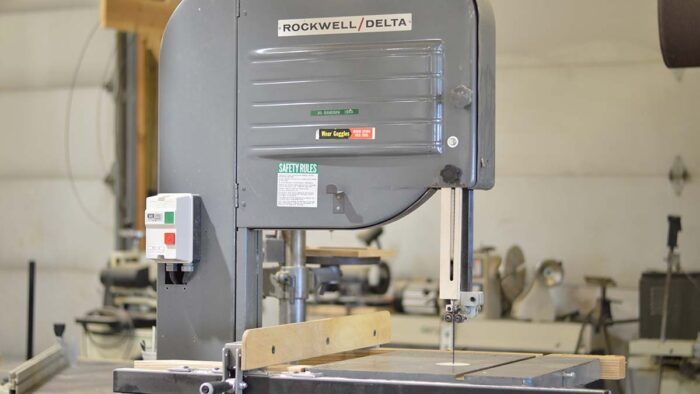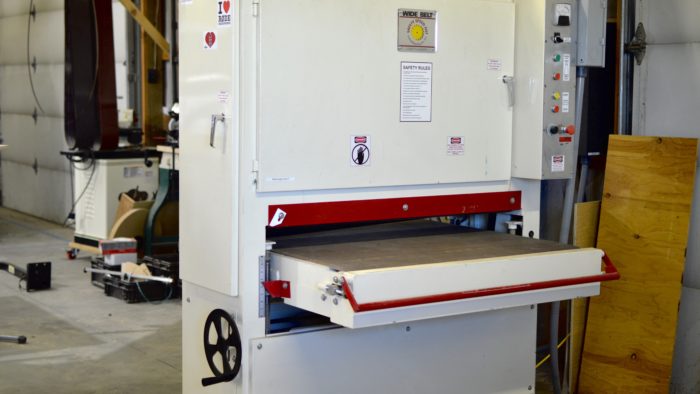Buying Used Shop Machines
Outfitting a shop with new machines is expensive, so here are a some tips for buying used.

When you walk into my shop, one of the first things you may notice is I’m in there working hard, and how incredibly handsome I am. The next most noticeable thing is that I have a bunch of tools. While I don’t have the most well-equipped shop on planet Earth, it’s outfitted pretty well for a small-time, one-man operation. This may lead you to think, “but yeah he’s broke ’cause he spent all his money on tools.” This would not be the case; I’m broke for other reasons. Over the years I have built up my tool collection by hunting for bargains and buying used. In my entire shop, I have only bought a couple of tools new, and the only reason for these is that I needed them right away to finish a job.
When I say tools I mean larger machines like jointers, planers, bandsaws, and so forth. I do not buy battery-powered or small-powered hand tools used, though I have had good luck buying reconditioned tools. I will also buy used handplanes, chisels, and measuring/marking tools.
Why bring this up? Because woodworking, especially fine woodworking, is excruciatingly expensive. I do this for a living and get paid to use my tools, and they are still expensive. In this blog post I wanted to talk about my strategy for building a tool collection and keeping costs within this solar system, or at least the Orion Arm of the Milky Way.

When I started working in the trades I was young and had virtually no money—and by virtually, I mean actually no money. The first big tool purchase I made was a tablesaw. After looking at all the $3,000 cabinet saws that were out of my budget, I came to the realization that I simply didn’t have the money. I am one who does not take on debt unless absolutely necessary, so I ended up buying a Powermatic 64A contractor’s saw from a friend’s dad who had recently upgraded. I paid $500 for the saw. It had a 30-in. Biesemeyer fence and even came with a Freud combo blade. I was in love; after all, it was a nice saw with a very good fence. After about five years I wanted more, a larger fence and table, more power, etc. I ended up finding a Powermatic PM66 with a 1984 manufacture date in almost new condition on Craigslist for $1,200. After buying that (and becoming friends with the seller) I sold the 64A for $450. This same story can be told about most of the tools in my shop. I save up, search for a deal, and find it. After I outgrow the tool, I sell it for even money or a tolerable loss. Wash, rinse, repeat.
The following paragraphs are a few tips and tricks I have picked up along the way.
Safety in numbers
The first thing to mention is safety. If you are meeting an unknown person from a classified ad, be safe. My first choice is to take a friend. This is a good idea for safety as well as to have extra hands for loading. If no one is available to go with you, tell someone the exact address and time of where you plan to meet the seller. Have them call you 10 minutes after the meeting time. Also, when I first contact a seller, I ask for additional pictures and details about the item for sale. If they don’t want to send more pictures and answer questions, I would not meet them. In addition to getting more information about the tool, it also will tell you something about the seller.
Kicking the tires
How do you judge the condition of a tool? Has it been beaten to death, or is there plenty of life left in it? The first thing to know is most woodworking machines are pretty simple. There is some cast iron and/or sheet metal, there are some bearings, and an electric motor. First, check all cast iron, and look for cracks (like it’s been dropped or tipped over). If there is sheet metal check all welds for cracks. Next, make sure the machine is unplugged, and check the motor. If possible, stick your nose as close to the motor as possible and smell for the telltale burnt electrical smell. Bearings are a little more difficult, but grab any moving parts (arbor on a tablesaw, spindle on a drill press) and try to wiggle and see if there is any play. Check for rust. Check the operation of handles and everything attached to the handles. Worm gears and trunnions on a tablesaw are a good example; make sure they work smoothly and that there is no visible damage. Don’t be afraid to stick your head in there to get a really good look. Probably equally as important as anything you can check with your hands is to size up the seller. Look at their shop (if you are meeting them at their shop). Is it clean and organized? Is their car washed, are the tires bald? All of these are very good cues as to how the tool was used / treated.

The risk is worth the reward
Even after a thorough check and test drive, there are no guarantees that this tool will work trouble-free for years to come. It’s a risk, but the vast majority of the time, when cared for, good-quality tools will last pretty much forever. Out of every tool I have bought used, the worst thing that has happened was I needed to rebuild one electric motor. It was on one of my shapers. I took the motor out and dropped it off at my local rebuilder and $220 later I was back in business. I paid $400 for the shaper, $220 for the rebuild, so for $620 I bought a $2,500-plus tool. Still a good deal in my book.
When buying a tool, if all I have to do is replace a bearing or two and otherwise the machine is in good working condition, I consider that a win. Especially when considering how well-made some of the older tools are. Lots more cast-iron, better machining, and design, etc. The point I’m making is older tools may need some attention. That’s part of what you are getting into when buying used tools, but in my humble estimation, it’s totally worth it.

One last piece of advice—study pricing for used tools in your area so you have an idea of what is and isn’t fair. If someone is high on price, make them a lower, more fair offer. If they say no, that’s fine, move on to the next one. It’s kinda like asking that girl to the dance—you’ll never know if you don’t ask. Always be prepared to walk away. If they won’t sell for a good price, or if the condition of the machine is not what you want, wait for the next one. There are other fish in the sea.
Reasons to buy new
The other side of my position is to buy new. If I had more money, I would probably go that route. If your life is busy with career, family, etc. you may not want to put the time into finding deals on used tools. Maybe you want to just walk out to the shop, turn on a tool, and get to work. Or the thought of repairing a tool doesn’t sound fun. Nothing wrong with that.
I think there is something addictive about old tools. Hunting for bargains is fun. Finding a diamond in the rough is a real rush. The feeling of using a beautifully machined tool with all-metal handles … knowing that a tool has been used by other craftsman and the stories it could tell … I promise I won’t recite a poem. I know it’s not for everyone, but I have built up a nice, and ever-expanding tool collection buying used.
If you would like to see one of the tools I recently purchased used, check out the link below. It’s an old Rockwell bandsaw out of a local Denver public school. It ended up needing a bearing in the lower headstock. From there I tricked it out with some other neat features. Since getting it up and running it has been a pleasure to use and perhaps my favorite tool. It’s about 60 years old. In those years I’m sure an untold number of students used it, perhaps it was their first time using a woodworking tool and this very saw sparked the woodworker within them. This is a heavy, well-made tool and there is no way I could afford this quality tool new.
Fine Woodworking Recommended Products

Hedgehog featherboards

Shop Fox W1826

Stanley Powerlock 16-ft. tape measure








Comments
I purchased a 16 inch joiner at a government sale for a 1000 dollars.It was a 1948 model with a three phase motor in almost perfect condition.Got a 150 $ static converter,new blades and was off and running
I love this type of video and Mike has a great persona. This makes me less anxious about buying older (and likely) better quality tools. I'd like to see more of these, please keep them coming!
Being a fan of "Old Iron" I loved this video. I have restored a few machines and find it very rewarding. May the video inspire others to do the same.
Please keep videos on this topic coming!
Thank you for this one!
Log in or create an account to post a comment.
Sign up Log in